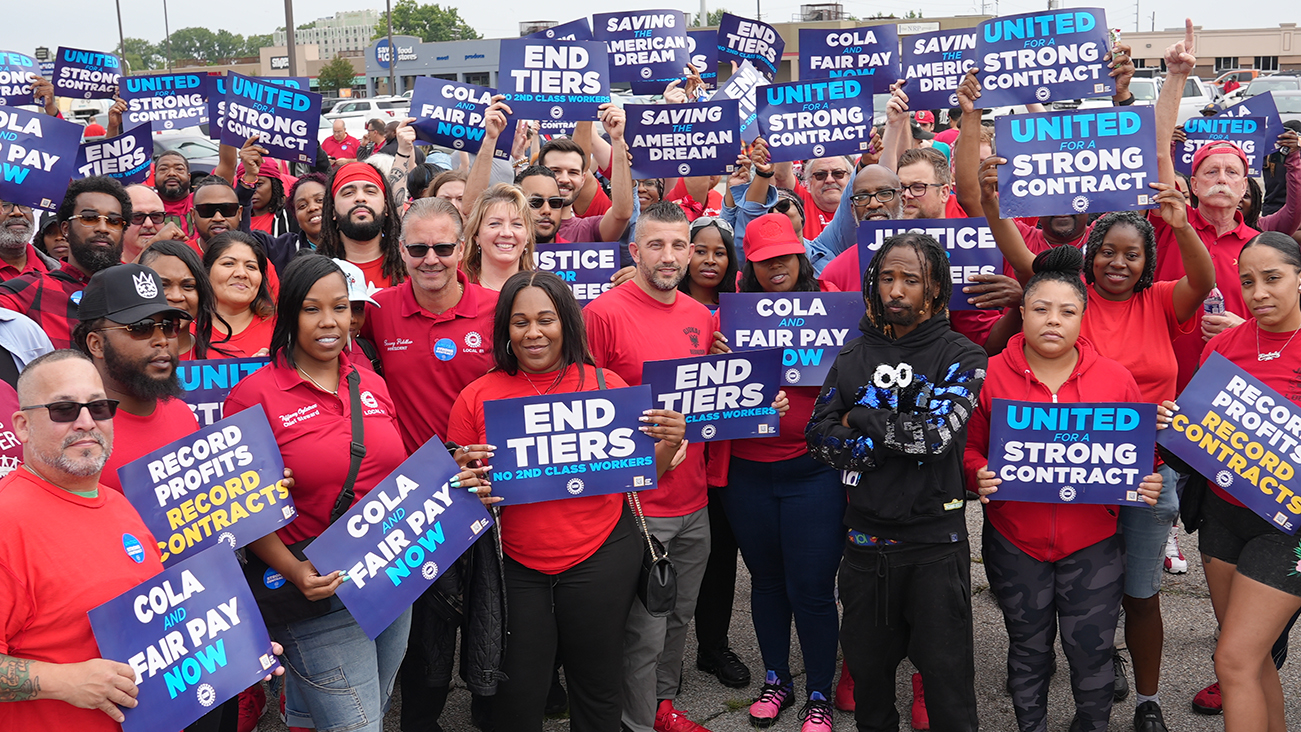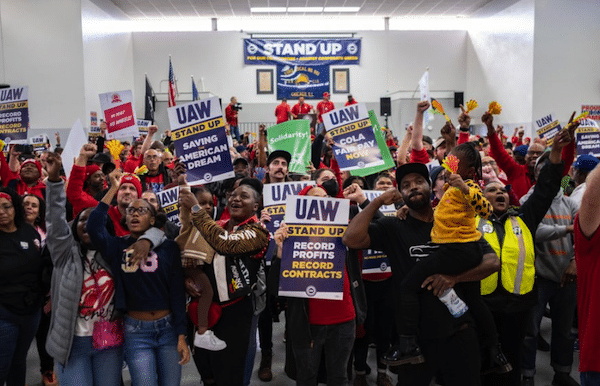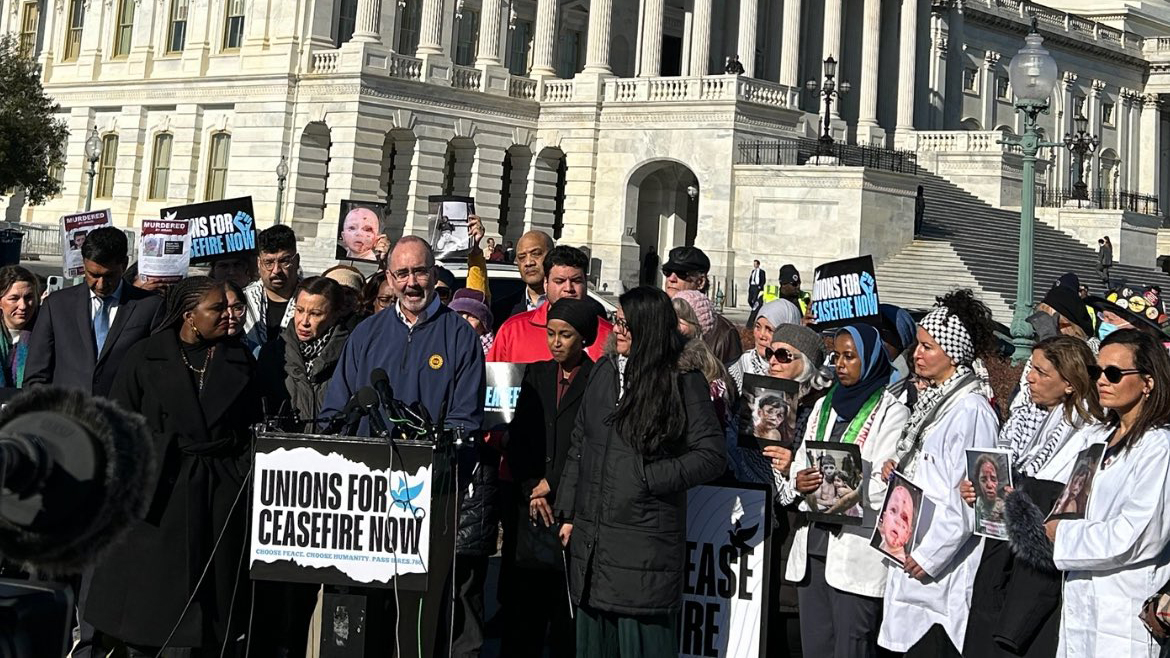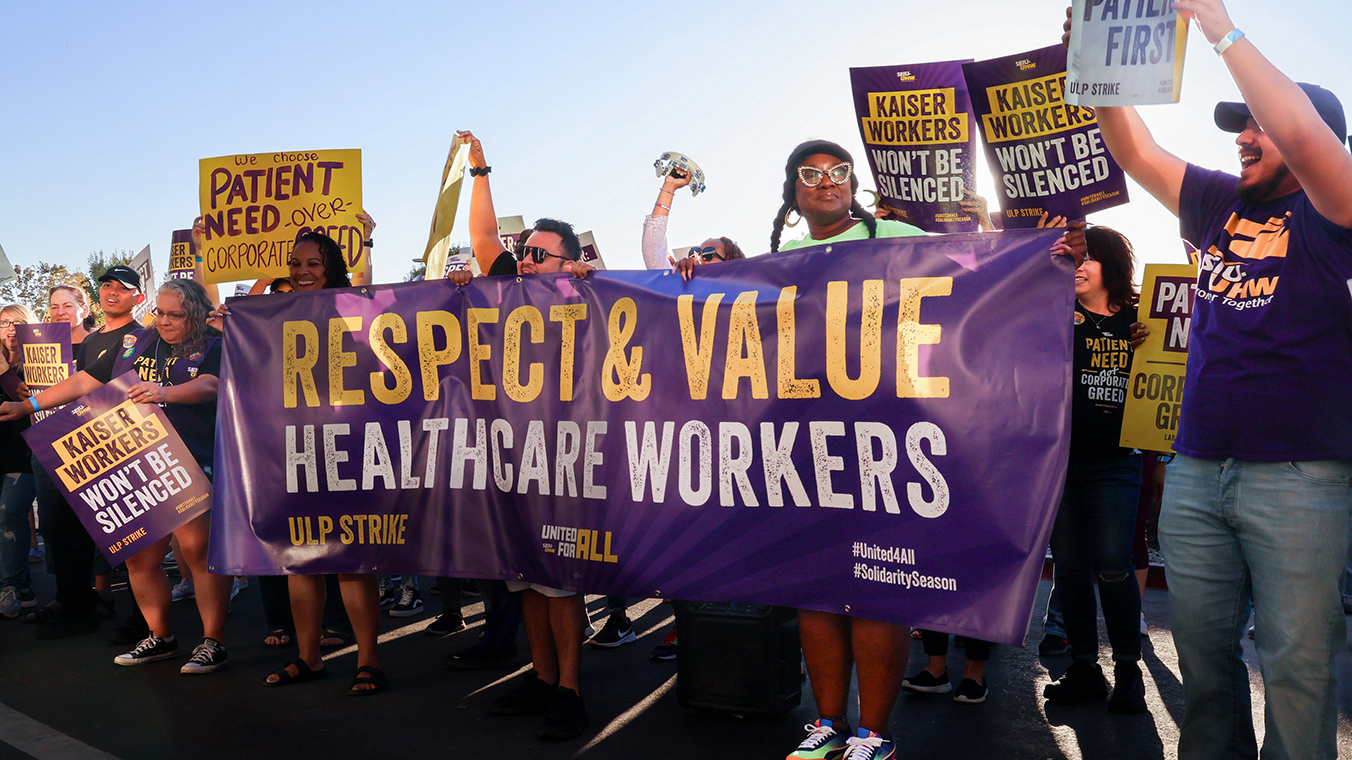The dawn of a working class upsurge
December 20, 2023 Stephen Millies

Actor Wanda Sykes, right, with Writers Guild of America members and supporters on a picket line outside NBCUniversal headquarters at 30 Rockefeller Plaza in New York, on May 23, 2023.
Presentation given at the Socialist Unity Party national plenum on Dec. 16, 2023.
Eighty-six-year-old Verna Mae Jackson was crushed to death on Dec. 6 while working at the FedEx world hub in the Memphis International airport.
Six months before, 16-year-old Michael Schuls was killed in a Florence, Wisconsin, sawmill near the border with Michigan’s Upper Peninsula.
What were an 86-year-old Black woman and a 16-year-old teenager doing in these dangerous jobs? Both of these tragedies were preventable.
Seventy years in age and 800 miles separated these two murdered workers. Maybe FedEx will be fined for unsafe conditions.
Florence Hardwoods was fined $190,000. It was found that the sawmill employed nine children, some as young as 14.
Yet, under Wisconsin law, it’s perfectly legal for teenagers to work in sawmills. Child labor is making a big comeback.
At the same time, the share of folks older than 60 in the workforce has doubled since 2000. By exploiting both the young and old, capitalism is extending the time that it extracts profits from us.
Karl Marx called this stealing “absolute surplus value.”
These two murders on the job are another sign of how much the working class has been pushed back in the last 50 years.
Look at the federal minimum wage. Because of the tremendous struggles of the 1960s, it was raised to $1.60 in February 1968.
To equal the purchasing power of that you would need at least $14.04 today. But the federal minimum wage has been frozen at $7.25.
That’s nearly a 50% drop in real terms, although many states, because of struggle, have raised their own minimum wage. These include California, Maryland, and New York.
In 1975, Wall Street demanded and got 50,000 New York City municipal workers fired. In the late 1970s, tens of thousands of Chrysler workers were laid off, most of whom were Black.
Reagan crushed the PATCO air traffic controllers’ strike in 1981 while AFL-CIO president Lane Kirkland did nothing.
He was busy helping to overthrow socialist Poland. Kirkland also served on Reagan’s Social Security Commission, which raised the retirement age.
Targeting Black workers
Big capital was determined to lessen its dependence on Black labor in basic industry. The Black-majority cities of Detroit and Flint, Michigan, and Gary, Indiana, were wrecked as hundreds of thousands of jobs were lost in auto and steel.
Fifty years ago, General Motors was the biggest employer of Black workers who were members of the UAW. Today, it’s non-union, poverty-wage Walmart.
Look at Baltimore. When I moved here in 1978, 20,000 or so workers were employed at Bethlehem Steel’s Sparrows Point mill, the largest in the world. Thousands more worked in shipyards, the Koppers factory, and at the GM plant.
All these unionized strongholds of our class were wiped out. Close to seven million manufacturing jobs, most of which were unionized, were destroyed coast-to-coast.
Seven million homes were foreclosed, and millions more evicted.
The biggest defeat was the overthrow of the Soviet Union. That was more dangerous than Hitler coming to power by crushing the German working class.
Yet the capitalist class can’t make a penny in profits without us. Thousands of Amazon workers now are employed at Sparrows Point.
Organizing drives at Amazon will make Jeff Bezos pay union wages and benefits. He might even have to trade in his $500 million yacht.
After decades of being beaten up, the U.S. multinational working class is fighting back! Capitalists are taking note.
A recent Wall Street headline read, “For Labor Unions, 2023 Was the Year of the Strike — and Big Victories.” The Cornell School of Industrial and Labor Relations has counted 354 strikes this year.
Back in 1933, one of the first working-class victories was winning unions in Hollywood. Movie making is big business.
Eighty years later, both the Writers Guild and the Screen Actors Guild went on strike for months in 2023, bringing the Hollywood moguls to their knees. Workers used their courage and intelligence to beat back artificial intelligence.
The Teamsters eliminated the hated two-tier pay scheme for drivers at UPS without going on strike. Wages for part-time workers were raised to $21 per hour.
That wasn’t enough for many part-timers, who justifiably wanted $25 in these inflationary times. I don’t think that Teamsters president Sean McBride settled for less because of pressure from the White House.
I think he was trying to show Amazon workers that by joining the Teamsters they can get more money, too, without a lengthy strike. We’ll see how that works out.
Solidarity with Palestine!
The Starbucks workers seem to be unbeatable. They continue to struggle in hundreds of stores across the country. They’ve got billionaire Howard Schultz on the run!
Nurses and other health care workers conducted 27 strikes across the United States. Picket lines were set up in New York and throughout California. There were also strikes in Hawaii, Illinois, Michigan, Oregon, St. Louis, and the state of Washington.
Workers at Rutgers and Temple universities went on strike as well as against colleges in Illinois.
The biggest star was the UAW strikes against the Big Three automakers that lasted more than six weeks. The union struck all three at once for the first time, although only striking a few selected chokepoints.
The hated pay tiers that were imposed in 2008 were smashed. The lowest-paid workers got the biggest wage increases. That’s what our late Comrade Vince Copeland advocated for decades.
Nonunion outfits like Toyota were so scared that they increased their wages, too. That won’t keep out the UAW. More than a thousand workers at Volkswagen have signed union cards.
Just as notable is UAW president Sean Fain’s demand for a ceasefire in Gaza. So had Mark Dimondstein, president of the American Postal Workers Union, who did so earlier.
Long gone are the days of George Meany supporting every filthy imperialist war. “Solidarity Forever” means solidarity with Palestine!
No railroad workers have any illusions about “Amtrak Joe,” who has now become “Genocide Joe” Biden. Despite being forbidden to strike by Congress, most railroaders were able to claw sick days out of the rail tycoons.
We are at the very beginning of a working-class upsurge. The actions that have been taken at Amazon warehouses are like those of the autoworkers in 1933 and 34.
The United Farmworkers Union is springing back to organize some of the poorest workers.
Who would have thought that small groups of Starbucks employees would stage work stoppages at hundreds of coffee shops? That takes enthusiasm and discipline.
We look forward to union drives at Walmart. The Teamsters will come to Memphis, where FedEx has 30,000 employees, and Verna Mae Jackson was killed.
The labor movement will come to some of the smallest towns just like the Black Lives Matter! movement did.
We’re mad as hell and we won’t take it anymore!
https://www.struggle-la-lucha.org/2023/ ... s-upsurge/
******
UE Members Take Action for Palestine Ceasefire
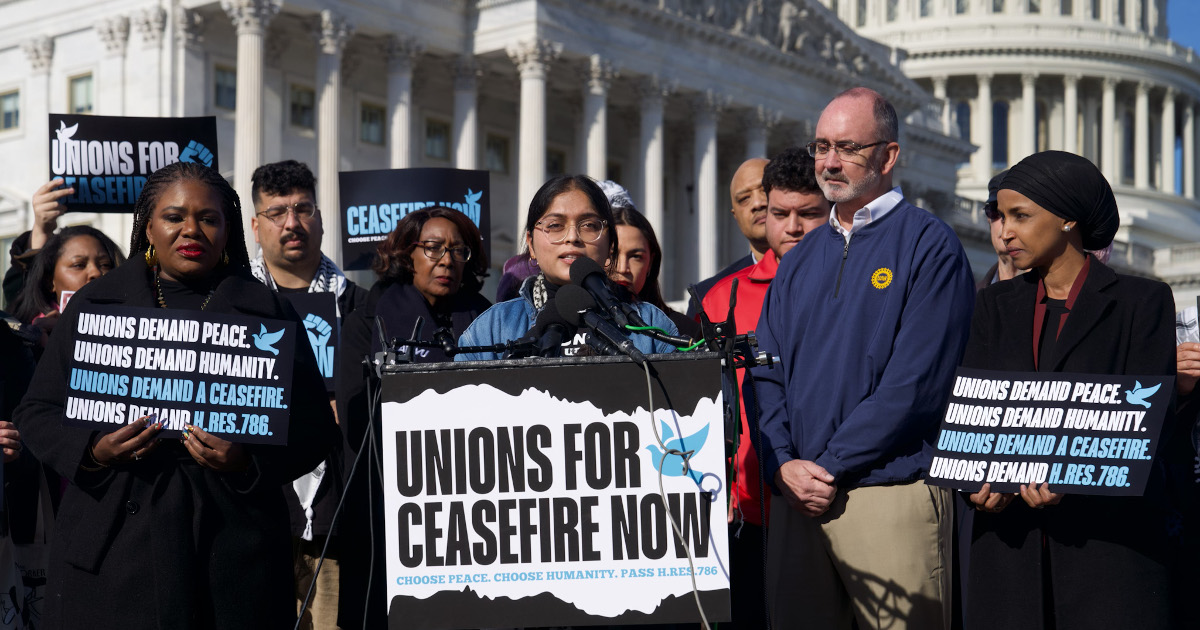
Janvi Madhani, UE Local 197-TRU, speaks at Unions for Ceasefire Now press conference
DECEMBER 15, 2023
Washington, DC and Pittsburgh
“In no other country is it more true that we, the workers, have a direct say in the plight of Palestinians,” declared Janvi Madhani of UE Local 197-Teachers and Researchers United at a press conference yesterday in the nation’s capital. “Our hard-earned tax dollars go directly towards the bombs being dropped in Gaza but not towards healthcare, housing, or education at home.”
Madhani was representing UE at a press conference, Unions for Ceasefire Now, organized by Rep. Cori Bush (D-MO).
“Since October 7, Israel’s escalation of violence in Gaza has killed more than 18,000 Palestinians,” she noted. “The Israeli campaign of terror has expelled more than 1.9 million Palestinians from their homes — more than 80 percent of the population. Israel does this all with impunity and with the United States’ explicit support.
“Time and time again, our government has initiated wars and destabilization campaigns around the world. To what end? The two major US wars of the past two decades, Iraq and Afghanistan, cost us billions of dollars while producing more extremism, more war, more instability, and more danger.”
UAW President Shawn Fain, who also spoke at the press conference, said, “as a labor movement, it’s up to us to stand up and fight for the best of what humanity is and can be. The UAW is proud to stand here with our fellow union family … to call for peace and to call for a ceasefire.”
Fain thanked rank-and-file UAW members for “speaking out and pushing us to come out in support of a ceasefire. It was the right thing to do. … And I call on the rest of the labor movement to join us in this mission for peace and social justice for all of humanity.”
Since UE and UFCW Local 3000 initiated a labor call for a ceasefire in Israel and Palestine in October, the UAW, American Postal Workers Union, National Nurses United and National Education Association, along with many regional and local unions, have all called for a ceasefire.
Madhani concluded her remarks by calling on President Biden to “immediately call for a ceasefire, halt unconditional aid to Israel, and immediately restore the basic rights of Palestinians who have been deprived of food, water, fuel, and life-saving medical aid so that the real work of justice for Palestinians can begin.”
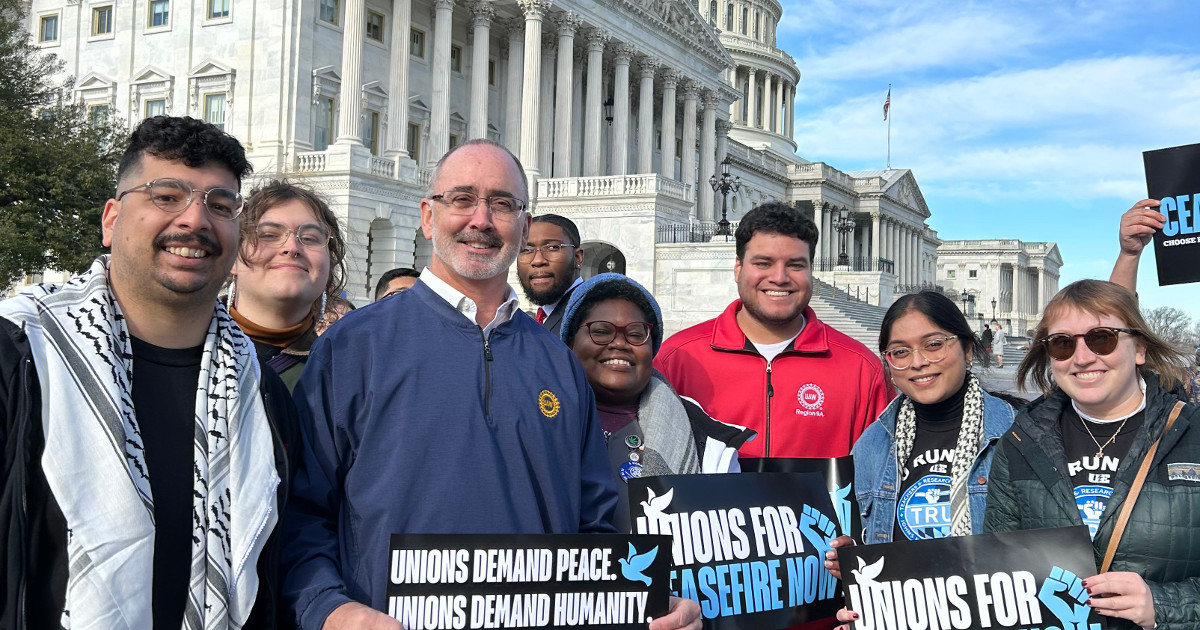
Left to right: Wisam Awadallah (Local 197), Sandy Peeples (Local 197), UAW President Shawn Fain, Chelsea Bland (CLUW), Brandon Mancilla (UAW Region 9A), Janvi Madhani (Local 197), Rachel Williams (Local 197).
Madhani was joined by several other members of Local 197 who traveled to Washington with her. Other speakers at the press conference were UAW Region 9A Director Brandon Mancilla, Judy Beard of the American Postal Workers Union, Chelsea Bland of the Coalition of Labor Union Women, Gene Bruskin, the national coordinator of National Labor Network for a Ceasefire, Reresentative Bush, and Representatives Rashida Tlaib (D-MI), Ro Khanna (D-CA), André Carson (D-IN), and Alexandria Ocasio-Cortez (D-NY)..
Political Action in Pittsburgh
On Monday, December 4, rank-and-file members of UE Locals 667 and 696 visited the offices of Senator John Fetterman (D-PA) and participated in a Zoom meeting with staff from the office of Senator Bob Casey (D-PA), demanding that the two senators support a ceasefire.
“War is a detriment to labor,” Local 667 President Fritz Geist told the senators’ staff, “as this project funnels resources, both monetary and human, into actions that result in the further alienation of human beings on both ends of the conflict. Currently, resources that could go into healthcare, education, housing, and infrastructure are instead funding the eradication of an entire nation of human beings overseas.”
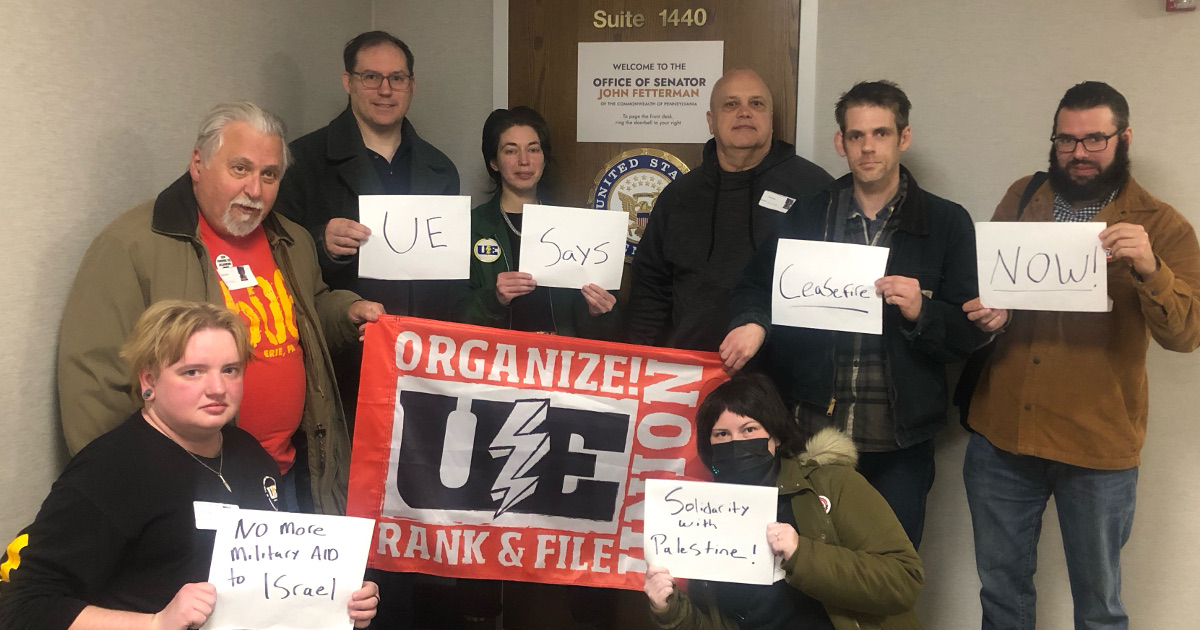
Left to right: Jason Lovell, Local 667, retired UE NEWS editor and Local 506 member Al Hart, UE Secretary-Treasurer Andrew Dinkelaker, Fritz Geist, Local 667, Eastern Region President George Waksmunski, Crystal Grabowski, Local 696 (seated), John Trapp, Local 667, and Field Organizer Ben Wilson.
Crystal Grabowski, Local 696, reminded Fetterman’s staff that their local union “put out a statement calling for a permanent ceasefire and the protection of health care workers and their patients in Gaza … after the International Planned Parenthood Federation clinic in Gaza was destroyed.” They blasted the office for simply ignoring their local’s demand, saying that “If Fetterman truly stands with unionized workers, then he doesn’t just get to ignore our demands while workers performing the same work that we do are slaughtered by Israel’s occupying forces in Gaza.”
Local 667 member Jason Lovell also expressed frustration with Fetterman’s “antagonism to people who disagree” with him, accusing the Senator of being “disrespectful” to his constituents.
“We cannot bomb our way to peace”
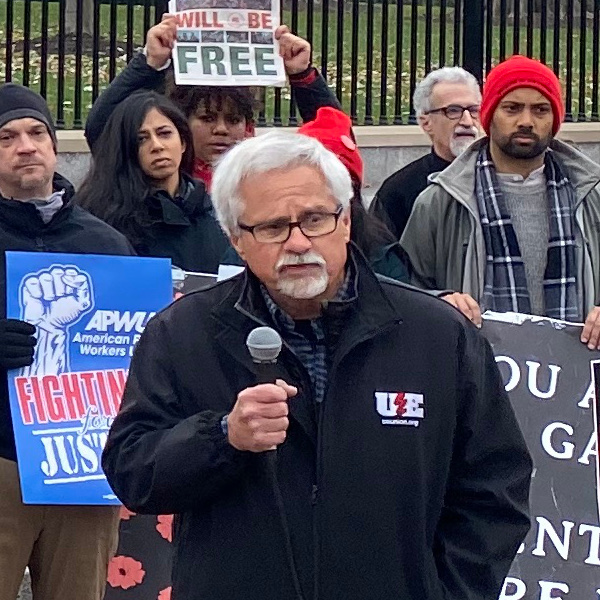
Retired UE Director of Organization Bob Kingsley.
The previous Friday, December 1, members of Local 197 had traveled from Baltimore to Washington, DC to join a labor press conference where retired UE Director of Organization Bob Kingsley spoke. “We cannot bomb our way to peace,” declared Kingsley. “In Gaza today, bombs paid for with our tax dollars are falling on the heads of ordinary workers just like the members of my union. On their families, too. It’s time to stop this, time to leverage the billions in U.S. aid we send to Israel to stop this rain of death and destruction on innocent civilians.”
Retired UE General President Peter Knowlton also spoke at a peace rally in Dartmouth, MA on December 10, where he likened “the intimidation and job discrimination faced by people today for supporting Palestinian rights” to the repression that UE faced during the McCarthy era.
https://www.ueunion.org/political-actio ... rs-join-ue
******
Southern Human Rights Organizing and the Amazon Workers' Struggle
Margaret Kimberley, BAR Executive Editor and Senior Columnist 20 Dec 2023

Jennifer Bates testifying before Senate Budget Committee hearing March 17, 2021
Jennifer Bates is an organizer with the BAmazon Union , the effort to organize Amazon warehouse workers in Bessemer, Alabama. BAmazon Union is affiliated with the Retail, Wholesale & Department Store Union (RWDSU). I spoke to Ms. Bates at the Southern Human Rights Organizers Conference (SHROC) which was recently held in Nashville. SHROC is an opportunity for human rights organizers and defenders to come together to share strategies, learn from each other, and build relationships. It’s a gathering of grassroots organizers and human rights defenders from across the U.S. and Global South. Ms. Bates and I discussed the history of the struggle in Bessemer, working conditions at Amazon, and the challenges of union organizing in the south.
Margaret Kimberley: What should we know about working conditions at Amazon warehouses?
Jennifer Bates: The working conditions are terrible. The working conditions don't have the employee at heart. Working at Amazon is more so profits over people. And there's a phrase I use to say, we're just a “sweep away.” So almost like if you fall out on the floor and pass away, they just take a broom and move you on and put someone else on your station.
I've never seen the injury rate like Amazon’s. And most of the time they rush to put employees back to work with injuries. They even call doctors. I had one doctor tell me they were trying to force them to release workers back to work knowing that they were still injured. They're not reporting to EEOC (the Equal Employment Opportunity Commission) like they should. And I think at one point where two people died within one day, like a night shift and the day shift. And that week, EEOC said that Amazon only reported one, even with the accidents, they said we have no lost time accidents, they're not reporting the injuries, because they are pressuring the employees to come back to work.
MK: People order from Amazon, because it's so fast. But that means the speed that most people like in getting something they want, that takes a toll on the workers, correct?
JB: That's correct. They are telling you we want more, but they don't think, they really don't care about the injuries that are caused. And we have people with back problems. People who have knee injuries, arm and hand injuries as well. I just had surgery a couple of months ago for an injury that I had. There are people on crutches, you know, people have fallen dead. Mandatory overtime during peak season, you know, people are ordering those packages. They’ve got to get them within two days, so they're pressuring their employees to get those packages out as fast as you can, which has taken a toll on them mentally as well.
MK: And what percentage of the workers at your warehouse are black?
JB: 80%
MK: And the other 20%?
JB: They are a mixture of Indian, white, Latino.
MK: And you've had I believe two votes to form a union and you've lost those votes. Why do you think you lost?
JB: Well, the first one we lost, the second one is still in court. Yes, we have a hearing within a few weeks. We still have ballots that haven't been counted yet. So we're waiting on the Labor Board to make a decision on that case, but what happened was in the first the first election, we had over 3,000 cards from employees who signed the cards, to state that they want a union and once we turn those cards in the Labor Board said okay, well, we got more than enough.
And I think the system is kind of weak when it comes down to our workers, because at that point, they gave the opportunity to the company, “Hey, it's time for you to run a campaign.” But why run a campaign when you have 3,000? They even had classes where they bring in employee relations people, you know, you're teaching the people in these captive audience classes, where you're saying that you're teaching them more about why they don't need a union. In fact, I call it confusion, and manipulation classes in fear tactics, because that's what I experienced in it, and you have people who are afraid, because Amazon ran their vote.
So they put their fear in the younger generation. And some of the older people, those people who may be the only income bringing the all income in the household, and they were in the south, right? Because we're in the south, there has always been a fear of bringing in unions or people going to lose their job, because why? Because it's low income anyway. And there has always been a fear pushing Alabama and the politicians designed to keep unions out. Because what happens is it gives power to the people.
MK: You know, that fear has to be very strong, because the conditions you described, one would think you'd want union representation. I'll call it propaganda to get people to vote no, when they clearly want to say yes. Given that the working conditions are so bad, how long do most people last? Is there a high turnover rate?
JB: Yes, high turnover. And Amazon is so bad that we can be teaching people on board to unionize one day, but then a few months later, those people are no longer there. Some people will decide that they can't stay to work under those conditions, or husbands or spouses say you know what you need to get out of there, I don't need you to work under a heartless company like that, you know, you're getting injured.
MK: How long have you worked there?
JB: I've worked there for three and a half years.
MK: And how did you come to be a leader in this organizing effort?
JB: When we first began, Darryl Richardson was the one who called RWDSU. But it was several of us who were talking about it who had been a part of unions before. Richardson and some others who came from another facility in Tuscaloosa, Alabama, who had been a part of unions and realized that what was going on there was an abuse of power.
People are getting fired. There was no opportunity to present their case to say that's not fair, or that's not true. So we knew the benefits of being a part of a union organization.
So I think, because I wasn't afraid of management, I pushed the campaign. Amazon tried to tell the employees that it's just the union who's just trying to come in here and take their money. So at some point, Darryl, and I had to come forth and say, “No, it's not just these people who are coming in here, there are a group of people who contacted RWDSU, because we want a union here.”
MK: We are meeting here at the Southern Human Rights Organizers Conference. Everyone in attendance is not from the south but we come to learn from people like yourself, about the work that you're doing. Tell us about why you came and why you think it's so important to have these opportunities to gather.
JB: Actually I spoke with Jaribu Hill and Aaron Greene earlier this year, in June, I was on a zoom with them. I like to learn. And because I like to learn, I also like to teach. And I realized that education is power. And without power, we can't move forward, without knowledge, we can't move forward. So I decided to go and I wanted to share what our efforts were and to share our struggles as well. And once I got to SHROC I realized that there were so many other dimensions of human rights in this country, and especially in the south, I didn't realize that there were other struggles, other than just in Alabama. And it was a blessing to me to not only teach, but to be taught and have knowledge.
MK: You said the vote is in court now, what is the process? What's going to happen next?
JB: We won't know until we go to the hearing. And I guess we'll give our testimonies on the illegal actions of Amazon during that campaign. There were a lot of illegal actions taken by them. And we get to present our evidence. We found a lot of you ULPs, unfair labor practices. There'll be a decision later on, on whether the Labor Board will rule in our favor that we will run a new election. We have 500 ballots that weren't counted. They were contested by Amazon. Those ballots will be counted, I think, and we'll just make a decision on whether the other election will be overturned, and we'll push another election or whether we'll be certified as a union. So the hearing hasn't been scheduled yet. It was supposed to be in September, but they postponed it and moved it up because we had to add a couple more charges. I think one was when they fired me at Amazon.
MK: But they reinstated you?
JB: Yes, they reinstated me the following week, but they still didn't allow me to work. They put me on a leave of absence. But they went to the media, and told the media, “Oh, yeah, we reinstated Jennifer Bates and it was a misunderstanding, a miscommunication, and that lets you know that our system works. We heard her side of the story. So they told a journalist that they reinstated me, but once I returned to work that day, it said that I was inactive. Because I had an injury I was on light duty, lifting 10 pounds or less. I went back to the doctor but each document I brought back, Amazon continued to deny.
MK: And how can people be supportive of your organizing efforts?
JB: Continue to tell our stories right now. And if we have other actions to come and be a part of them. Open avenues like social media, if you see an article about what’s going on use your platforms to get the word out.
MK: Thank you.
https://blackagendareport.com/southern- ... s-struggle
******
“It Looks Like the Railroad Is Asking for You to Say Thank You”
by Jessica Lussenhop and Topher Sanders
Dec. 19, 6 a.m. EST

Former brakeman Chris Cole lost both of his legs while working for Kansas City Southern Railway Company. Credit:Bryan Birks for ProPublica
After brakeman Chris Cole lost both his legs on the job, railroad officials removed evidence before state regulators could see it, omitted key facts in reports and suspended him from a job he could never return to.
ProPublica is a nonprofit newsroom that investigates abuses of power. Sign up to receive our biggest stories as soon as they’re published.
CHRIS COLE LAY ON HIS BACK in the gravel beside the railroad tracks, staring up at the overcast sky above Godfrey, Illinois. He could not see below his waist — a co-worker had thrown himself over Cole’s body to spare him the sight, although the man couldn’t keep himself from repeating: “Oh my god, Chris. Oh my god.” So, instead of looking down where his legs and feet should have been, Cole looked up. What’s going to happen to my family? he remembered thinking.
Moments earlier, Cole — a 45-year-old brakeman, engineer and conductor with over two decades of experience working on the railroads — had attempted a maneuver he’d done many times: hoisting himself onto a locomotive as it moved past him. Although dangerous, Cole’s employer, Kansas City Southern Railway Company, did not prohibit workers from climbing on and off equipment that was moving at a “walking speed.” In fact, the company went from banning the practice in the mid-’90s to steadily increasing the permissible speed at which workers could attempt to climb onboard, a change other freight companies would also adopt in keeping with the spirit of a modern strategy to move cargo as quickly as possible.
As he pulled himself up onto the rolling train, Cole said he felt something strike his right shoulder — a rectangular metal sign close to the tracks that read “DERAIL.” He lost his balance and slipped beneath the wheels of a graffiti-covered boxcar. The train crushed and nearly severed his right foot and his left leg at the knee.
Somehow Cole maintained consciousness, calling his co-workers for help before undoing his belt to tie a tourniquet around one of his legs. As the engineer dialed 911, the conductor ran to Cole’s side and used his own belt to tie a second tourniquet around the other leg. A crew of firefighters arrived within minutes. They loaded him onto a medical helicopter that airlifted Cole to an emergency room in St. Louis, just across the nearby Missouri border.
Cole awoke in the middle of the night alone in a hospital room; it was April 2020, just a month after the surging coronavirus was declared a pandemic. Neither his wife nor his daughter were allowed to visit, and so he was alone when a trauma nurse informed him that he lost both of his legs. Cole, a burly man who once stood 6 feet tall, knew his railroading career was over, as were his hopes of providing enough so that his wife — who’d recently been diagnosed with multiple sclerosis — could stay at home with their 12-year-old daughter.
The next morning, Cole called his manager to tell him that he was alive. Afterward, the manager wrote an email to other members of the company summarizing Cole’s description of the accident: “Upon mounting equipment he stated there was a derail sign that struck him off of the engine and he fell.”
But within days, according to company and court records, Cole’s managers and higher-ups at the rail company began to shape a new narrative — one that erased the role of the sign, leaving Cole solely at fault, entitled to nothing under the railroad industry’s version of workers’ compensation for his devastating injuries.
“The culture of management is that we are going to cover ourselves and cover the railroad and make sure that it doesn’t look bad in the public eye,” Cole said. “And if we got to bury one of our employees, or somebody else, we’re going to do that.”
In many ways, the fight centered on the metal derail sign. Within 48 hours of the accident, before state regulators had a chance to examine it, the sign was gone.
Railroad companies have a long history of hiding injuries, as ProPublica recently reported. But in some catastrophes like Cole’s, in which the injuries are so grievous they can’t be denied, ProPublica found that companies moved almost immediately to cover up their culpability.
Some attempts to deny the causes of accidents obscured safety hazards, such as faulty latches, which could have put more workers at risk, ProPublica found. Others took actions that made worker injuries far worse.
In 2014, after two BNSF workers in Minneapolis breathed in a cloud of highly toxic chemicals that may have vented from passing rail cars, managers claimed that the men were exposed to a far less dangerous substance. One of the workers, Scott Kowalewski, suffered severe, permanent neurological damage. The other later died by suicide, a tragedy that was impossible to incontrovertibly link to the accident.
When Kowalewski sued, BNSF claimed that he didn’t say he was exposed to the more toxic material until three-and-a-half years after the incident and maintained throughout the case that his deteriorating health had nothing to do with the exposure. But a jury sided with Kowalewski in 2018 and awarded him $15.3 million. And a judge concluded that the railroad’s “misrepresentation prevented Kowalewski from receiving appropriate medical treatment that might have remediated his injury.” The judge ordered BNSF to pay an additional $5.8 million penalty for its misconduct, writing that the extent of it was “vast, and spans from the outset of its initial sham investigation.”
Cole’s case wasn’t even the first involving a railroad sign. Bradley Anderson was riding on the side ladder of a rail car in 2019 when he struck his head on a milepost sign that was too close to the tracks. He was diagnosed with a traumatic brain injury. Officials from his company, BNSF, pulled the sign out of the ground before its position was adequately documented.
This July, the federal judge on Anderson’s case excoriated the company. “Despite receiving multiple court admonitions for destroying and concealing evidence, BNSF engaged in the same type of misconduct here,” U.S. District Judge Rebecca Goodgame Ebinger wrote in an order, declaring that the company was responsible for Anderson’s injury, and approved sanctions for the damage caused by the “bad faith” removal of the sign. The case eventually settled.
She also said she was forwarding the case to the Iowa Supreme Court Attorney Disciplinary Board and the Illinois Attorney Registration and Disciplinary Commission, “in the event either body should see fit to initiate an investigation into an apparent abuse of legal procedure.”
Neither of those bodies would disclose to ProPublica whether they had received the judge’s referral or whether they planned to act on the information.
In civil litigation, it falls on workers’ attorneys to prove companies tampered with evidence. If a judge agrees, they can sanction the companies for millions of dollars or, in an extreme case, even enter a default judgment for the worker. (The judges in Kowalewski’s and Anderson’s cases entered such default judgments against BNSF.) But outside of those repercussions, there is little else in terms of punishment for companies that repeat the behavior. “It comes out in an individual case,” said Daniel Gourash, editor of the American Bar Association book “Spoliation of Evidence.” “The sanction that would be given would not be because of a habitual spoliation activity or conduct or behavior.”
BNSF did not comment on either case but said in a statement that “the safety of our employees always has been and always will be a priority. We believe that’s reflected in our safety culture and record over the last decade, which produced the lowest number of injuries in our railroad’s history.”
In a statement to ProPublica on the Cole case, a Canadian Pacific Kansas City spokesperson denied that any of its actions were an attempt to avoid culpability. (This year, Kansas City Southern Railway Company merged with Canadian Pacific Railway.)
“Through a thorough investigation that lasted several months, Kansas City Southern sought to determine how the incident occurred so appropriate action could be taken to prevent such an incident from happening again,” the company said.
Within hours of Cole’s accident, a bevy of Kansas City Southern supervisors from across the region converged at the scene. They took pictures. They stayed until dark fell.
Early the next morning, Cole called two of his managers from his hospital bed: assistant trainmaster Michael Cline and Chris Knox, general manager of the KCS North Division. Cline sent two emails to several managers at the company: “He stated there was a derail sign that struck him off of the engine and he fell between the engine and cars where the incident took place with the dismemberment of his legs.” Cline told ProPublica he would check with his employer before commenting but then did not respond further. Knox didn’t respond to calls or text messages.
A short time later, four inspectors from the Federal Railroad Administration gathered at the scene along with KCS managers. An FRA operating practices inspector named Larry Piper wrote up his initial findings about what happened to Cole.
“His body struck a derail sign on a metal post adjacent to the pass track, knocking him off the locomotive and to the ground,” the report stated, adding that railroad and FRA officials watched video footage captured on a nearby security camera. “Even though the quality was not perfect, it did substantiate what the employee was saying,” the report said.
Piper communicated those findings to a member of the Illinois Commerce Commission, the agency that performs inspections and enforces state regulations on the railroad, including sign placement.
“It appeared to him that the derail post sign was too close to the rail,” recalled Dennis Mogan, the ICC railroad safety specialist, in a deposition. “The FRA didn’t have any regulations on that, and he thought that the state did and that we should take a look.”
But before that could happen, KCS roadmaster Jeffrey Brickey removed the sign and pulled its pole from the ground entirely. He also covered the hole left behind.
“We’re not supposed to leave any divots or anything like that for trainmen to walk on, so yeah, I cleaned it up,” he testified. Brickey did not respond to ProPublica’s requests for comment.
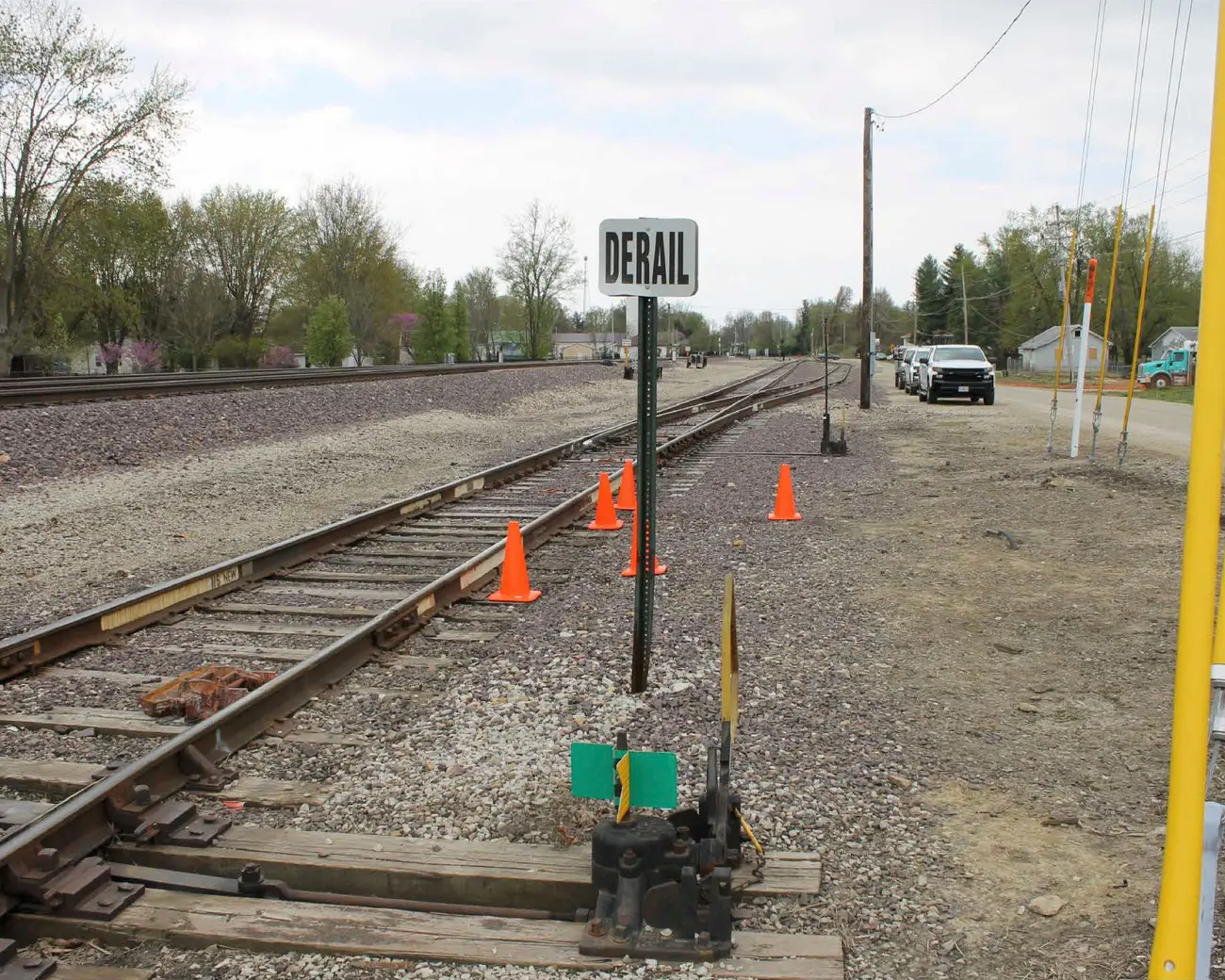
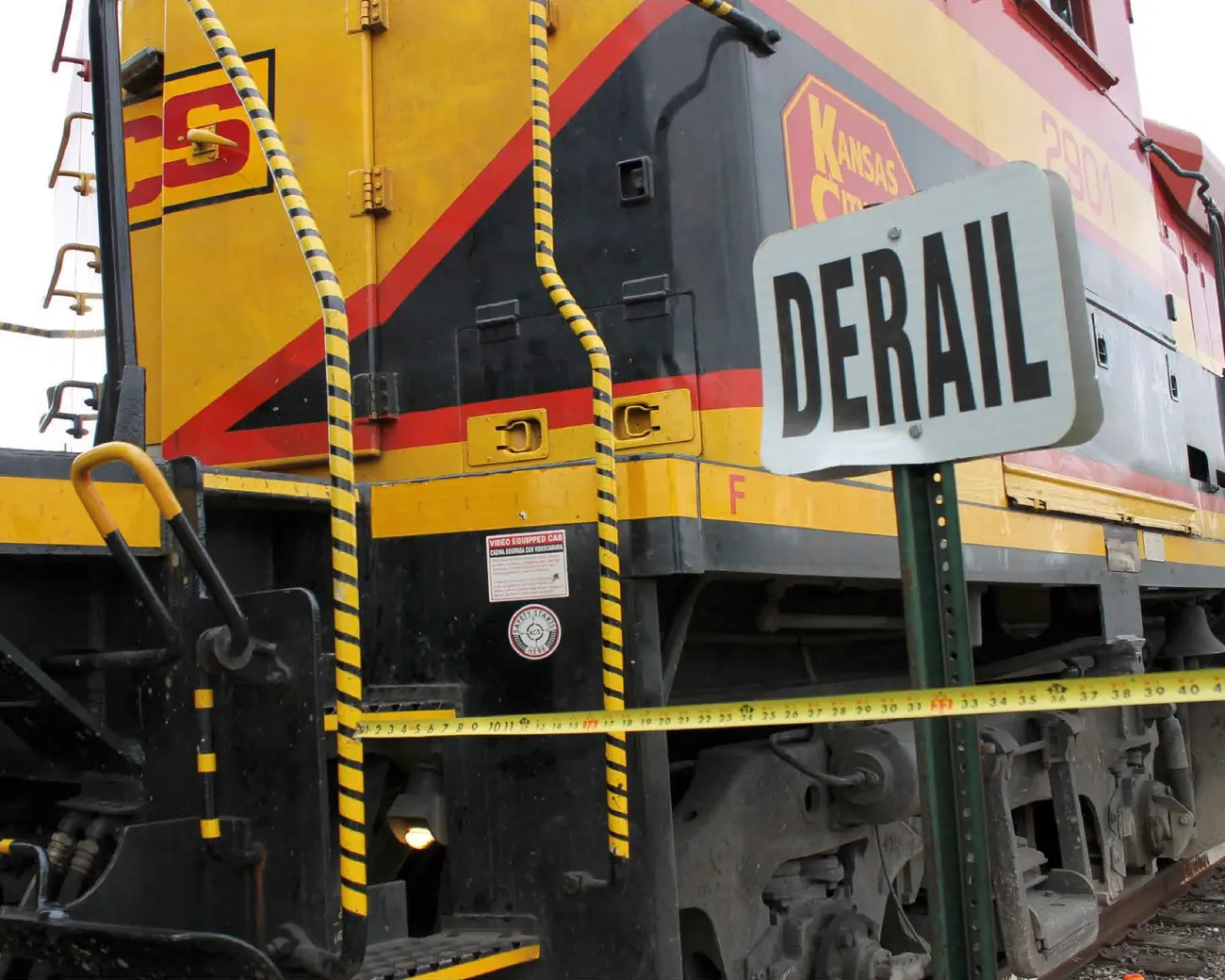
Photos taken by a KCS representative show the derail sign after Cole’s accident. Credit:Court records
By the time a railroad safety specialist from the ICC named Troy Fredericks arrived about a week later, the sign was long gone. When Fredericks asked Brickey about it, he said Brickey “couldn’t discuss” the sign and “would not talk about” the injury incident. The company did not comment on whether it had been forthright with Illinois regulators; the ICC told ProPublica that Brickey was “responsive to ICC Staff’s concern in the days after the incident.” Before Fredericks left the accident scene, he made note of a completely different sign not far away that he said was positioned too close to the railroad tracks and then left.
Around the same time that the sign disappeared from the site, it also began to fade from the railroad company’s narrative of the incident, despite the existence of the FRA’s initial report confirming Cole’s account. Wendell Campbell, an assistant division superintendent who was one of the first to arrive in Godfrey after the accident, wrote on an employee injury form that the sign struck Cole. But in subsequent paperwork, Campbell omitted any mention of the sign: “Employee was trying to board moving equipment.” Campbell declined to comment when reached by ProPublica.
(Much more at link.)
https://www.propublica.org/article/trai ... es-lawsuit

